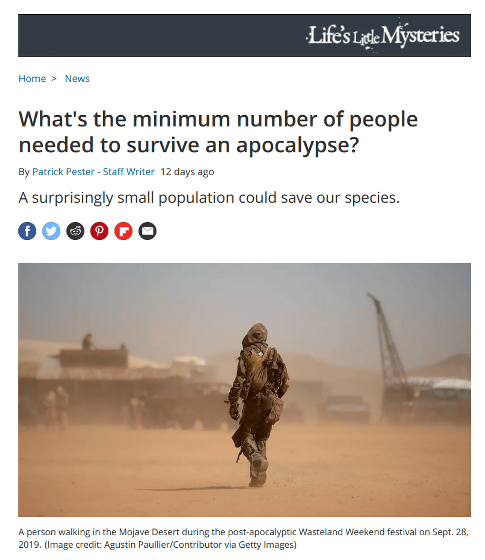What is the minimum population required to keep humanity alive in the world of Postapocalypse?

The possibility that humans on Earth will almost die due to nuclear wars involving the entire world, collisions of asteroids, the progress of global warming, and the epidemic of unknown viruses is not zero. Live Science, a scientific media, explains the minimum population required for humankind to survive in the
What's the minimum number of people needed to survive an apocalypse? | Live Science
https://www.livescience.com/minimum-people-to-survive-apocalypse.html

'The type of disaster that hit people' has a great influence on how to survive in the world of Postapocalypse, but if you focus on 'population size' without detailed conditions, it is about the world population at the time of writing the article. It can be very small compared to 7.8 billion people.
'A population of less than a few hundred can probably survive for centuries,' said Cameron Smith, who teaches human evolution and prehistory at Portland State University in Oregon. He also states that in fact this kind of small population on Earth has survived for centuries and sometimes thousands of years.
Smith points out that big cities that rely on imports for much of their food and rely on electricity are extremely vulnerable to the collapse of civilization and will not survive in the post-apocalyptic world. Therefore, the surviving populations may spread at low population densities to find the remaining resources, rather than forming large settlements.

According to Smith, in the early Neolithic era when humans began farming (after the end of the last ice age-about 12,000 years ago), small villages with a population of hundreds to 1,000 people were found all over the world. It is said that many were formed in. 'They were fairly independent groups, but I think they also had interrelationships with other villages in breeding and marriage, and I think the same thing happens in apocalyptic scenarios,' Smith said. I will.
Populations that have to keep their population alive with just a few hundred people need to build a system to maintain their reproductive system. Reproductive problems faced by closed populations include reduced genetic diversity due to inbreeding and mating with genetically close partners. For example, the
Similar problems can occur in small populations that survive in the post-apocalyptic world, so genetic compatibility needs to be confirmed during reproductive behavior, and if another population exists, keep in touch and keep in touch. It is also important to take in new genes on a regular basis. In addition, it is also an issue whether it is possible to secure enough individuals in the age group that can simply breed.

In addition to the possibility that a small population is thinly distributed, there is also a scenario in which survivors gather in a shelter constructed in advance for emergencies and live in large numbers.
For example, in the pandemic of the new coronavirus infection (COVID-19), there were few infected people in island countries such as New Zealand, and it was virtually a “large-scale shelter”. Thus, setting up a large shelter somewhere on Earth could be useful in the post-apocalyptic world, which Baum said was the Svalbard Global Seed Vault built in preparation for plant extinction. Is comparing with.

by Landbruks- og matdepartementet
It is also possible that humans living in the post-apocalyptic world will give up on Earth and escape to another planet. In a 2018 paper by astrophysicist Frédéric Marin and colleagues at the University of Strasbourg, France, the population will be maintained if the giant spacecraft migrates to Proxima Centauri b , the closest celestial body to the Earth, over 300 years. It is concluded that 98 crew members are needed for this.
In this case, the crew of the spacecraft heading to Proxima Centauri b does not randomly select 98 people, but instead consists of 49 'breedable male and female pairs' who are not related to each other and prepare to have children. It is necessary to be able to do it. Breeding must also be tightly controlled and restricted to ensure the genetic diversity of the entire crew.
The number of 98 people is the minimum required, and the paper states that it is desirable to carry a crew of 500 people in order to secure more genetic diversity. Smith also pointed out that it is dangerous to take off with the minimum required number of 98 people, and that we should escape the earth with a sufficient number of people.

Related Posts:
in Note, Posted by log1h_ik







